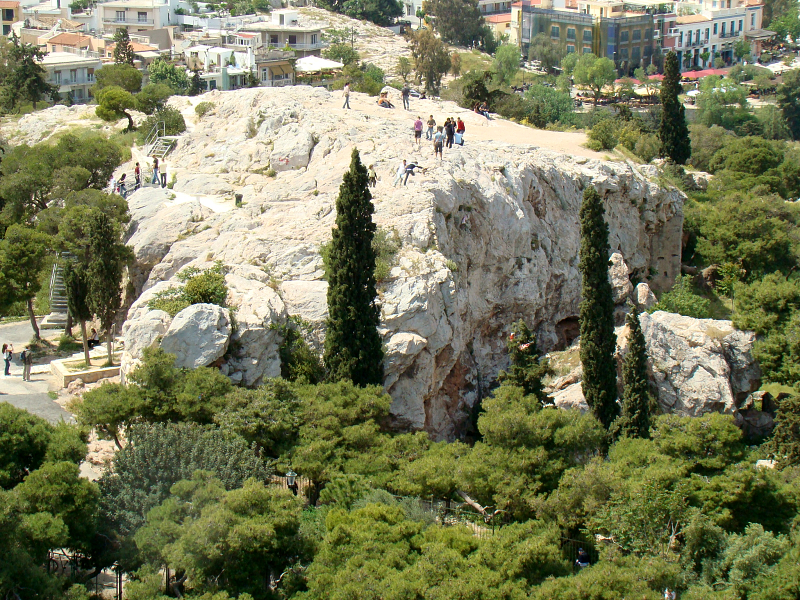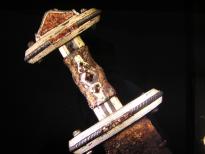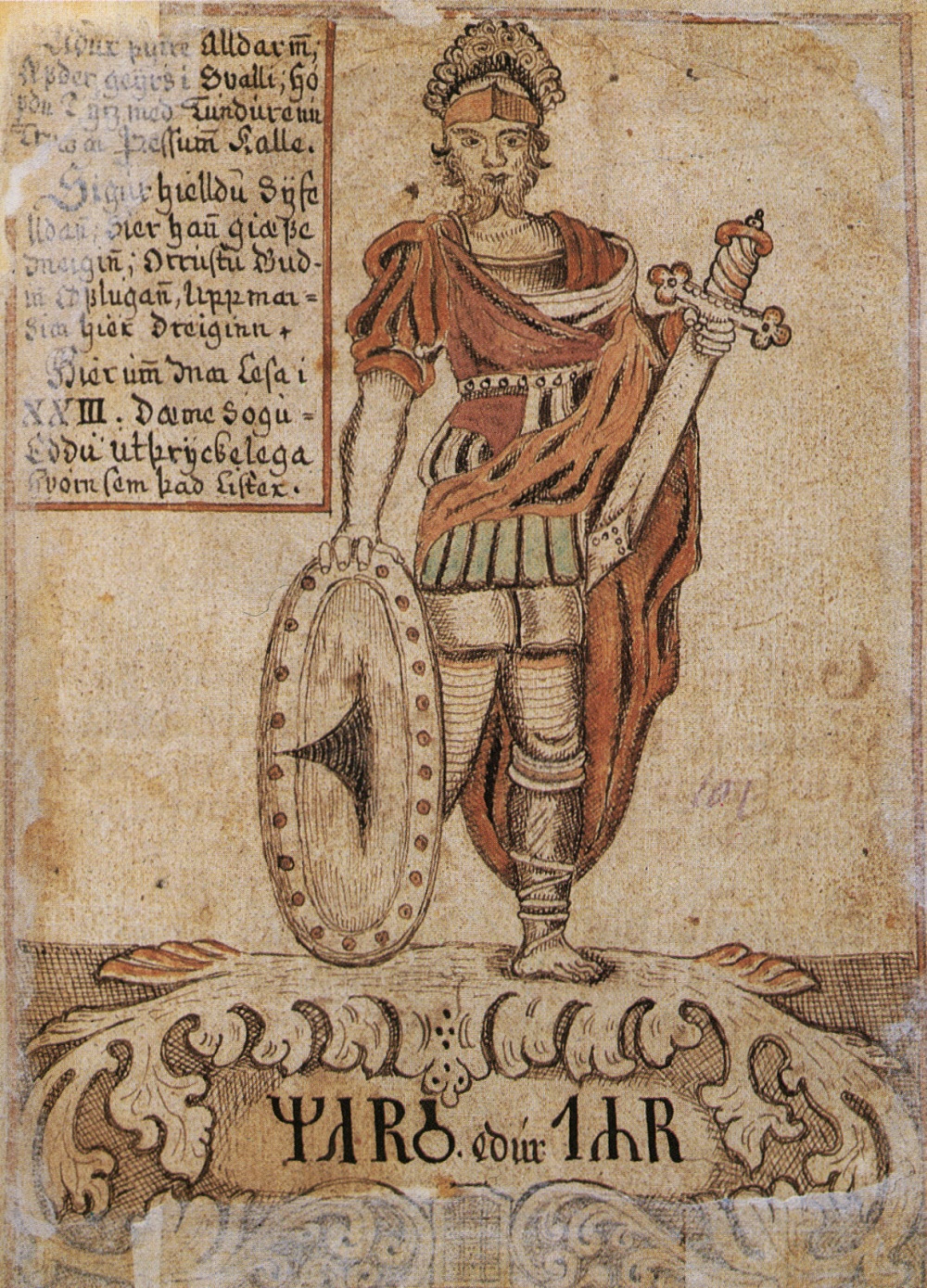|
Ear (rune)
The ''Ear'' rune of the Anglo-Saxon futhorc is a late addition to the alphabet. It is, however, still attested from epigraphical evidence, notably the Thames scramasax, and its introduction thus cannot postdate the 9th century. Transliteration It is transliterated as ''ea'', and the Anglo-Saxon rune poem glosses it as :''ᛠ arbyþ egle eorla gehƿylcun, / ðonn fæstlice flæsc onginneþ, / hraƿ colian, hrusan ceosan / blac to gebeddan; bleda gedreosaþ, / ƿynna geƿitaþ, ƿera gesƿicaþ.'' :" 'ear''is horrible to every knight, / when the corpse quickly begins to cool / and is laid in the bosom of the dark earth. / Prosperity declines, happiness passes away / and covenants are broken." Jacob Grimm's interpretation Jacob Grimm in his 1835 '' Teutonic Mythology'' ch. 9 attached a deeper significance to the name. He interprets the Old English poem as describing "death personified", connected to the death-bringing god of war, Ares. He notes that the ''ear ... [...More Info...] [...Related Items...] OR: [Wikipedia] [Google] [Baidu] |
Runic Letter Ear
Runes are the letters in a set of related alphabets known as runic alphabets native to the Germanic peoples. Runes were used to write various Germanic languages (with some exceptions) before they adopted the Latin alphabet, and for specialised purposes thereafter. In addition to representing a sound value (a phoneme), runes can be used to represent the concepts after which they are named (ideographs). Scholars refer to instances of the latter as ('concept runes'). The Scandinavian variants are also known as ''futhark'' or ''fuþark'' (derived from their first six letters of the script: '' F'', '' U'', '' Þ'', '' A'', '' R'', and '' K''); the Anglo-Saxon variant is ''futhorc'' or ' (due to sound-changes undergone in Old English by the names of those six letters). Runology is the academic study of the runic alphabets, runic inscriptions, runestones, and their history. Runology forms a specialised branch of Germanic philology. The earliest secure runic inscriptions date from aro ... [...More Info...] [...Related Items...] OR: [Wikipedia] [Google] [Baidu] |
Areopagus
The Areopagus () is a prominent rock outcropping located northwest of the Acropolis in Athens, Greece. Its English name is the Late Latin composite form of the Greek name Areios Pagos, translated "Hill of Ares" ( grc, Ἄρειος Πάγος). The name ''Areopagus'' also referred, in classical times, to the Athenian governing council, later restricted to the Athenian judicial council or court that tried cases of deliberate homicide, wounding and religious matters, as well as cases involving arson of olive trees, because they convened in this location. The war god Ares was supposed to have been tried by the other gods on the Areopagus for the murder of Poseidon's son Halirrhothius (a typical example of an aetiological myth). History The exact origin of the Areopagus is unclear. In pre-classical times (before the 5th century BC), the Areopagus may have been a council of elders for the city of Athens, and membership was restricted to those who had held high public office, in ... [...More Info...] [...Related Items...] OR: [Wikipedia] [Google] [Baidu] |
Migration Period Sword
The Migration Period sword was a type of sword popular during the Migration Period and the Merovingian period of European history (c. 4th to 7th centuries AD), particularly among the Germanic peoples. It later gave rise to the Carolingian or Viking sword type of the 8th to 11th centuries AD. The blade is normally smooth or shows a very shallow fuller, and often has multiple bands of pattern-welding within the central portion. The handles were often of perishable material and there are few surviving examples. Blade length measured between 28" and 32" (710 and 810 mm) in length and 1.7" to 2.4" (45 to 60 mm) in width. The tang has a length of only some 4" to 5" (100 to 130 mm) long. The blades show very little taper, usually ending in a rounded tip. Surviving examples of these Merovingian-period swords have notably been found in the context of the Scandinavian Germanic Iron Age ( Vendel period). Names and terminology There is no single term that can be reconstruct ... [...More Info...] [...Related Items...] OR: [Wikipedia] [Google] [Baidu] |
Tuesday
Tuesday is the day of the week between Monday and Wednesday. According to international standard ISO 8601, Monday is the first day of the week; thus, Tuesday is the second day of the week. According to some commonly used calendars, however, especially in the United States, Sunday is the first day of the week, so Tuesday is the third day of the week. In Muslim countries, Saturday is the first day of the week and thus Tuesday is the fourth day of the week. The English name is derived from Old English ''Tiwesdæg'' and Middle English ''Tewesday,'' meaning "Tīw's Day", the day of Tiw or Týr, the god of single combat, and law and justice in Norse mythology. Tiw was equated with Mars in the interpretatio germanica, and the name of the day is a translation of Latin ''dies Martis''. Etymology The name ''Tuesday'' derives from the Old English and literally means "Tiw's Day". Tiw is the Old English form of the Proto-Germanic god ''*Tîwaz'', or Týr in Old Norse. ''*Tîwaz'' deriv ... [...More Info...] [...Related Items...] OR: [Wikipedia] [Google] [Baidu] |
Marcomanni
The Marcomanni were a Germanic people * * * that established a powerful kingdom north of the Danube, somewhere near modern Bohemia, during the peak of power of the nearby Roman Empire. According to Tacitus and Strabo, they were Suebian. Origin It is believed their name may derive from Proto-Germanic ''*markō'' "border, boundary" (hence the English ''march'' or ''mark'', meaning "frontier, border", as in the Welsh marches and the kingdom of Mercia) and ''*mann-'' (pl. ''*manniz'') "man", ''*Markōmanniz'', which would have been rendered in Latinised form as ''Marcomanni''. The Marcomanni first appear in historical records as confederates of the Suebi of Ariovistus fighting against Julius Caesar in Gaul (now France) after they had crossed the Rhine from what is now southern Germany. The exact position of their lands at the time is not known. The fact that their name existed before the Romans had territory near the Danube or Rhine raises the question of which border they li ... [...More Info...] [...Related Items...] OR: [Wikipedia] [Google] [Baidu] |
Bavaria
Bavaria ( ; ), officially the Free State of Bavaria (german: Freistaat Bayern, link=no ), is a state in the south-east of Germany. With an area of , Bavaria is the largest German state by land area, comprising roughly a fifth of the total land area of Germany. With over 13 million inhabitants, it is second in population only to North Rhine-Westphalia, but due to its large size its population density is below the German average. Bavaria's main cities are Munich (its capital and largest city and also the third largest city in Germany), Nuremberg, and Augsburg. The history of Bavaria includes its earliest settlement by Iron Age Celtic tribes, followed by the conquests of the Roman Empire in the 1st century BC, when the territory was incorporated into the provinces of Raetia and Noricum. It became the Duchy of Bavaria (a stem duchy) in the 6th century AD following the collapse of the Western Roman Empire. It was later incorporated into the Holy Roman Empire, ... [...More Info...] [...Related Items...] OR: [Wikipedia] [Google] [Baidu] |
Westphalia
Westphalia (; german: Westfalen ; nds, Westfalen ) is a region of northwestern Germany and one of the three historic parts of the state of North Rhine-Westphalia. It has an area of and 7.9 million inhabitants. The territory of the region is almost identical with the historic Province of Westphalia, which was a part of the Kingdom of Prussia from 1815 to 1918 and the Free State of Prussia from 1918 to 1946. In 1946, Westphalia merged with North Rhine, another former part of Prussia, to form the newly created state of North Rhine-Westphalia. In 1947, the state with its two historic parts was joined by a third one: Lippe, a former principality and free state. The seventeen districts and nine independent cities of Westphalia and the single district of Lippe are members of the Westphalia-Lippe Regional Association (''Landschaftsverband Westfalen-Lippe''). Previous to the formation of Westphalia as a province of Prussia and later state part of North Rhine-Westphalia, t ... [...More Info...] [...Related Items...] OR: [Wikipedia] [Google] [Baidu] |
Anglo-Saxon Runes
Anglo-Saxon runes ( ang, rūna ᚱᚢᚾᚪ) are runes used by the early Anglo-Saxons as an alphabet in their writing system. The characters are known collectively as the futhorc (ᚠᚢᚦᚩᚱᚳ ''fuþorc'') from the Old English sound values of the first six runes. The futhorc was a development from the 24-character Elder Futhark. Since the futhorc runes are thought to have first been used in Frisia before the Anglo-Saxon settlement of Britain, they have also been called Anglo-Frisian runes. They were likely to have been used from the 5th century onward, recording Old English and Old Frisian. They were gradually supplanted in Anglo-Saxon England by the Old English Latin alphabet introduced by Irish missionaries. Futhorc runes were no longer in common use by the eleventh century, but The Byrhtferth's Manuscript (MS Oxford St John's College 17) indicates that fairly accurate understanding of them persisted into at least the twelfth century. History There are competin ... [...More Info...] [...Related Items...] OR: [Wikipedia] [Google] [Baidu] |
Eresburg
The Eresburg is the largest, well-known (Old) Saxon refuge castle (''Volksburg'') and was located in the area of the present German village of Obermarsberg in the borough of Marsberg in the county of Hochsauerlandkreis. It was a hill castle built on the plateau of a low table hill, known as the ''Eresberg'', at a height of 130–150 metres above the Diemel, a tributary of the Weser, in the extreme south of the Saxon Gau of Engern on the border with the Duchy of Franconia. History There is evidence that indicates the hill was settled even in prehistoric times. Pieces of pottery from the Michelsberg culture have also been found here. Excavations in the vicinity of the present-day collegiate church have revealed traces of ditches, ramparts and posts. Radio carbon dating points to their origin in the pre-Roman Iron Age. In addition the wooden posts were made from trees that can be dated to between 420 and 370 B.C. Earlier research viewed the Eresburg as a border ... [...More Info...] [...Related Items...] OR: [Wikipedia] [Google] [Baidu] |
Tyr Rune
The ''t''-rune is named after Týr, and was identified with this god. The reconstructed Proto-Germanic name is *Tîwaz or *Teiwaz. Tiwaz rune was an ideographic symbol for a spear. Rune poems Tiwaz is mentioned in all three rune poems. In the Icelandic and Norwegian poems, the rune is associated with the god Týr. Usage Ancient Multiple Tiwaz runes Multiple Tiwaz runes either stacked atop one another to resemble a tree-like shape, or repeated after one another, appear several times in Germanic paganism: ::* The charm (''alu'') on the Lindholm amulet, dated from the 2nd to the 4th century, contains three consecutive ''t'' runes, which have been interpreted as an invocation of Týr. ::* The Kylver Stone (400 AD, Gotland) features 8 stacked Tiwaz runes at the end of an Elder Futhark inscription. ::* From 500 AD, a Scandinavian C-bracteate (Seeland-II-C) features an Elder Futhark inscription ending with three stacked Tiwaz runes. Poetic Edda According to the runologist Lars Ma ... [...More Info...] [...Related Items...] OR: [Wikipedia] [Google] [Baidu] |






_nach_Merian_1646.jpg)